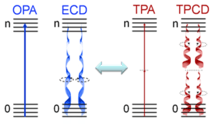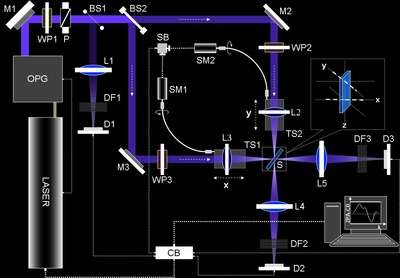Two-photon circular dichroism
Two-photon circular dichroism (TPCD), the nonlinear counterpart of electronic circular dichroism (ECD), is defined as the differences between the two-photon absorption (TPA) cross-sections obtained using left circular polarized light and right circular polarized light (see Figure 1).[1]

Background
Typically, two-photon absorption (TPA) takes place at twice the wavelength as one-photon absorption (OPA). This feature allows for the TPCD based study of chiral systems in the far to near ultraviolet (UV) region. ECD cannot be employed in this region due to interferences from strong linear absorption of typical buffers and solvents and also because of the scattering exhibited by inhomogeneous samples in this region. Several other advantages are associated with the use of non-linear absorption, i.e. high spatial resolution, enhanced penetration depth, improved background discrimination and reduced photodamage to living specimens.[2] In addition, the fact that TPA transitions obey different selection rules than OPA (even-parity vs. odd-parity) leads to think that in chiral molecules ECD and TPCD should present different spectral features, thus making the two methods complementary. TPCD is very sensitive to small structural and conformational distortions of chiral molecules, and therefore, is potentially useful for the fundamental study of optically active molecules. Finally, TPCD has the potential to penetrate into the far-UV region, where important structural/conformational information is typically obscure to ECD. This would enable the discovery of new information about molecular systems of interest such as, peptides, biological macromolecules (allowing for a deeper understanding of diseases like Alzheimer's and Parkinson's) and potential candidates for negative refractive index (for the developing of cloaking devices).
TPCD has been applied in experiments using pump-probe,[3] intensity dependent multiphoton optical rotation,[4] resonance-enhanced multiphoton ionization,[5][6] and polarization modulation single beam Z-scan.[7] The first experimental measurement of TPCD was performed in 1995 using a fluorescence based technique (FD-TPCD),[8] but it was not until the introduction of the double L-scan technique in 2008 by Hernández and co-workers,[9] that a more reliable and versatile technique to perform TPCD measurements became available. Since the introduction of the double L-scan several theoretical-experimental studies based on TPCD have been published, i.e. TPCD of asymmetric catalysts,[10][11][12] effect of the curvature of the π-electron delocalization on the TPCD signal,[13] fragmentation-recombination approach (FRA) for the study of TPCD of large molecules[14][15] and the development of an FD-TPCD based microscopy technique.[16] Additionally, Rizzo and co-workers have reported purely theoretical works on TPCD.[17][18][19][20][21][22][23]
Theory
TPCD was theoretically predicted by Tinoco[24] and Power[25] in 1975, and computationally implemented three decades later by Rizzo and co-workers,[26] using DALTON[27] and later[28] at the CC2 level in the TURBOMOLE package. The expression for TPCD, defined as, , was obtained by Tinoco in his 1975 paper as a semiclassical extension of the TPA formulae.[24] Quantum electrodynamical equivalent expressions were obtained by Power,[25] by Andrews[29] and, in a series of papers, by Meath and Power[30][31][32][33] who were able to generalize the approach to the case of n photons,[32] and considered also the modifications occurring in the formulae when elliptical polarization is assumed.[33]
TPCD can be obtained theoretically using Tinoco’s equation[24]
where is the circular frequency of the incident radiation, is the circular frequency for a given 0→f transition, is the TPCD rotatory strength, is a normalized lineshape, is the electric constant and is the speed of light in vacuum.
, is obtained from
where the terms refer to the experimental relative orientation of the two incident photons. For the typical double-L scan setup, , and , which corresponds to two left or right circularly polarized photons propagating parallel to each other and in the same direction. The molecular parameters are obtained from the following equations,
where the molecular parameters are defined in function of the two-photon generalized tensors, (involving magnetic transition dipole matrix elements), (involving electric transition dipole matrix elements in the form of the velocity operator) and (including electric quadrupole transition matrix elements, in the velocity formulation).
Experiments
Double L-scan
The double L-scan is an experimental method that allows obtaining simultaneously polarization dependent TPA effects in chiral molecules. Performing measurements on equal “twin” pulses allows compensating for energy and mode fluctuations in the sample that can mask the small TPCD signal.[9]
To briefly describe the setup, short pulses coming from the excitation source (typically an OPG or an OPA) are split into “twin” pulses (at BS2), then the polarization of the pulses is controlled individually using quarter-waveplates (WP2 and WP3), allowing to perform simultaneous polarization dependent measurements. The sample is held in a 1 mm quartz cuvette and the incident angle of the light coming from both arms (M2 and M3) is 45°. The two incident beams have a separation on the vertical axis of about 1 cm, to avoid interference effects. Unlike Z-scan, in the double L-scan the sample is at fixed position and two identical focusing lenses (L2 and L3) move along the propagation axis (z axis). Calibration is required to ensure that z1= z2 during the entire scan.

See also
- Cryptochirality
- Specific rotation
- Circular dichroism
- Birefringence
- Geometric phase
- Polarization
- Levorotation and dextrorotation
- Chirality (chemistry)
- Polarization rotator
- Hyper Rayleigh Scattering Optical Activity
- Raman optical activity (ROA)
References
- Hernández, F.E.; Rizzo, A. (2011). "Two-Photon Polarization Dependent Spectroscopy in Chirality: A Novel Experimental-Theoretical Approach to Study Optically Active Systems". Molecules. 16: 3315–3337. doi:10.3390/molecules16043315.
- Denk, W.; Strickler, J.; Webb, W. (1990). "Two-Photon Laser Scanning Fluorescence Microscopy". Science. 248 (4951): 73–76. Bibcode:1990Sci...248...73D. doi:10.1126/science.2321027. PMID 2321027.
- Mesnil, H.; Hache, F. (2000). "Experimental evidence of third-order nonlinear dichroism in a liquid of chiral molecules". Phys. Rev. Lett. 85: 4257–4260. Bibcode:2000PhRvL..85.4257M. doi:10.1103/PhysRevLett.85.4257. PMID 11060612.
- Cameron, R.; Tabisz, G.C. (2007). "Characterization of intensity-dependent optical rotation phenomena in chiral molecules in solution". J. Chem. Phys. 126: 224507. Bibcode:2007JChPh.126v4507C. doi:10.1063/1.2743959.
- Li, R.; Sullivan, R.; Al-Basheer, W.; Pagni, R.M. (2006). "Compton, R. N., Linear and nonlinear circular dichroism of R-(+)-3-methylcyclopentanone". J. Chem. Phys. 125: 144304. Bibcode:2006JChPh.125n4304L. doi:10.1063/1.2338519.
- Bornschlegl, A.; Logé, C.; Boesl, U. (2007). "Investigation of CD effects in the multi photon ionisation of R-(+)-3-methylcyclopentanone". Chem. Phys. Lett. 447: 187–191. Bibcode:2007CPL...447..187B. doi:10.1016/j.cplett.2007.09.012.
- Markowicz, P.P.; Samoc, M.; Cerne, J.; Prasad, P. N.; Pucci, A.; Ruggeri, G. (2004). "Modified Z-scan Techniques for Investigations of Nonlinear Chiroptical Effects". Opt. Express. 12: 5209–5214. Bibcode:2004OExpr..12.5209M. doi:10.1364/OPEX.12.005209. hdl:10440/398.
- Gunde, K.E.; Richardson, F.S. (1995). "Fluorescence-Detected Two-Photon Circular Dichroism of Gd3+ in Trigonal Na3[Gd(C4H4O5)3] • 2NaClO4 • 6H2O". Chem. Phys. 194: 195–206. Bibcode:1995CP....194..195G. doi:10.1016/0301-0104(95)00025-J.
- DeBoni, L; Toro, C.; Hernández, F.E. (2008). "Synchronized Double L-Scan Technique for the Simultaneous Measurement of Polarization-Dependent Two-Photon Absorption in Chiral Molecules". Opt. Lett. 33: 2958–2960. Bibcode:2008OptL...33.2958D. doi:10.1364/OL.33.002958.
- Toro, C.; De Boni, L.; Lin, N.; Santoro, F.; Rizzo, A.; Hernandez, F. E. (2010). "Two-Photon Absorption Circular Dichroism: A New Twist in Nonlinear Spectroscopy". Chem. Eur. J. 16: 3504–3509. doi:10.1002/chem.200902286.
- Díaz, C.; Echevarria, L.; Rizzo, A.; Hernández, F. E. (2014). "Two-Photon Circular Dichroism of an Axially Dissymmetric Diphosphine Ligand with Strong Intramolecular Charge Transfer". J. Phys. Chem. 118 (5): 940–946. Bibcode:2014JPCA..118..940D. doi:10.1021/jp4119265.
- Lin, N.; Santoro, F.; Zhao, X.; Toro, C.; De Boni, L.; Hernández, F. E.; Rizzo, A. (2011). "Computational Challenges in Simulating and Analyzing Experimental Linear and Nonlinear Circular Dichroism Spectra. R-(+)-1,1'-bis(2-naphthol) as a Prototype Case". J. Phys. Chem. B. 115: 811–824. doi:10.1021/jp108669f.
- Díaz, C.; Lin, N.; Toro, C.; Passier, R.; Rizzo, A.; Hernández, F. E. (2012). "The Effect of the π-Electron Delocalization Curvature on the Two-Photon Circular Dichroism of Molecules with Axial Chirality". J. Phys. Chem. Lett. 3: 1808–1813. doi:10.1021/jz300577e.
- Díaz, C.; Echevarria, L.; Hernández, F. E. (2013). "Overcoming the Existent Computational Challenges in the Ab Initio Calculations of the Two-Photon Circular Dichroism Spectra of Large Molecules using a Fragment-Recombination Approach". Chem. Phys. Lett. 568–569: 176–183. Bibcode:2013CPL...568..176D. doi:10.1016/j.cplett.2013.03.019.
- Díaz, C.; Echevarria, L.; Hernández, F. E. (2013). "Conformational Study of an Axially Chiral Salen Ligand in Solution using Two-Photon Circular Dichroism and the Fragment-Recombination Approach". J. Phys. Chem. 117: 8416–8426. Bibcode:2013JPCA..117.8416D. doi:10.1021/jp4065714.
- Savoini, M.; Wu, X.; Celebrano, M.; Ziegler, J.; Biagioni, P.; Meskers, S. C. J.; Duò, L.; Hecht, B.; et al. (2012). "Circular Dichroism Probed by Two-Photon Fluorescence Microscopy in Enantiopure Chiral Polyfluorene Thin Films". J. Am. Chem. Soc. 134: 5832–5835. doi:10.1021/ja209916y. PMID 22413739.
- Rizzo, A.; Jansík, B.; Pedersen, T. B.; Agren, H. (2006). "Origin Invariant Approaches to the Calculation of Two-Photon Circular Dichroism". J. Chem. Phys. 125: 64113. Bibcode:2006JChPh.125f4113R. doi:10.1063/1.2244562.
- Jansík, B.; Rizzo, A.; Agren, H. (2007). "b Initio Study of the Two-Photon Circular Dichroism in Chiral Natural Amino Acids". J. Phys. Chem. B. 111: 446–460. doi:10.1021/jp0653555.
- Jansík, B.; Rizzo, A.; Agren, H.; Champagne, B. (2008). "Strong Two-Photon Circular Dichroism in Helicenes: A Theoretical Investigation". J. Chem. Theory Comput. 4: 457–467. doi:10.1021/ct700329a.
- Lin, N.; Santoro, F.; Zhao, X.; Rizzo, A.; Barone, V. (2008). "Vibronically Resolved Electronic Circular Dichroism Spectra of (R)-(+)-3-Methylcyclopentanone: A Theoretical Study". J. Phys. Chem. A. 112: 12401–12411. Bibcode:2008JPCA..11212401L. doi:10.1021/jp8064695.
- Rizzo, A.; Lin, N.; Ruud, K. (2008). "Ab Initio Study of the One- and Two-Photon Circular Dichroism of R-(+)-3-Methyl-Cyclopentanone". J. Chem. Phys. 128: 164312. Bibcode:2008JChPh.128p4312R. doi:10.1063/1.2907727.
- Lin, N.; Santoro, F.; Rizzo, A.; Luo, Y.; Zhao, X.; Barone, V. (2009). "Theory for Vibrationally Resolved Two-Photon Circular Dichroism Spectra. Application to (R)-(+)-3-Methylcyclopentanone". J. Phys. Chem. A. 113: 4198–4207. Bibcode:2009JPCA..113.4198L. doi:10.1021/jp8105925.
- Guillaume, M.; Ruud, K.; Rizzo, A.; Monti, S.; Lin, Z.; Xu, X. (2010). "Computational Study of the One- and Two-Photon Absorption and Circular Dichroism of (L)-Tryptophan". J. Phys. Chem. B. 114: 6500–6512. doi:10.1021/jp1004659.
- Tinoco, I. (1975). "Two-Photon Circular Dichroism". J. Chem. Phys. 62: 1006–1009. Bibcode:1975JChPh..62.1006T. doi:10.1063/1.430566.
- Power, E.A. (1975). "Two-Photon Circular Dichroism". J. Chem. Phys. 63: 1348–1350. Bibcode:1975JChPh..63.1348P. doi:10.1063/1.431521.
- Jansík, B.; Rizzo, A.; Agren, H. (2005). "Response Theory Calculations of Two-Photon Circular Dichroism". Chem. Phys. Lett. 414: 461–467. Bibcode:2005CPL...414..461J. doi:10.1016/j.cplett.2005.08.114.
- Aidas, K.; Angeli, C.; Bak, K.; et al. (2013). "The Dalton quantum chemistry program system". Wiley Interdiscip. Rev. Comput. Mol. Sci.
- Friese, D.; Hattig, C.; Rizzo, A. (2016). "Origin-independent two-photon circular dichroism calculations at the coupled cluster level". Phys. Chem. Chem. Phys. 19: 13683–13692. Bibcode:2016PCCP...1813683F. doi:10.1039/c6cp01653g.
- Andrews, D.L. (1976). "A Two-Chromophore Model for Two-Photon Circular Dichroism". Chem. Phys. 16: 419–424. Bibcode:1976CP.....16..419A. doi:10.1016/0301-0104(76)80088-2.
- Meath, W.J.; Power, E.A. (1984). "On the importance of permanent moments in multiphoton absorption using perturbation theory". J. Phys. B: At. Mol. Phys. 17: 763–781. Bibcode:1984JPhB...17..763M. doi:10.1088/0022-3700/17/5/017.
- Meath, W.J.; Power, E.A. (1984). "On the effects of diagonal dipole matrix elements in multi-photon resonance profiles using two-level systems as models". Mol. Phys. 51 (3): 585–600. Bibcode:1984MolPh..51..585M. doi:10.1080/00268978400100411.
- Meath, W.J.; Power, E.A. (1987). "Differential multiphoton absorption by chiral molecules and the effect of permanent moments". J. Phys. B: At. Mol. Phys. 20 (9): 1945–1964. Bibcode:1987JPhB...20.1945M. doi:10.1088/0022-3700/20/9/011.
- Meath, W.J.; Power, E.A. (1989). "On the Interaction of Elliptically Polarized Light with Molecules; the Effects of Both Permanent and Transition Multipole Moments on Multiphoton Absorption and Chiroptical Effects". J. Mod. Opt. 36 (7): 977–1002. Bibcode:1989JMOp...36..977M. doi:10.1080/09500348914551031.